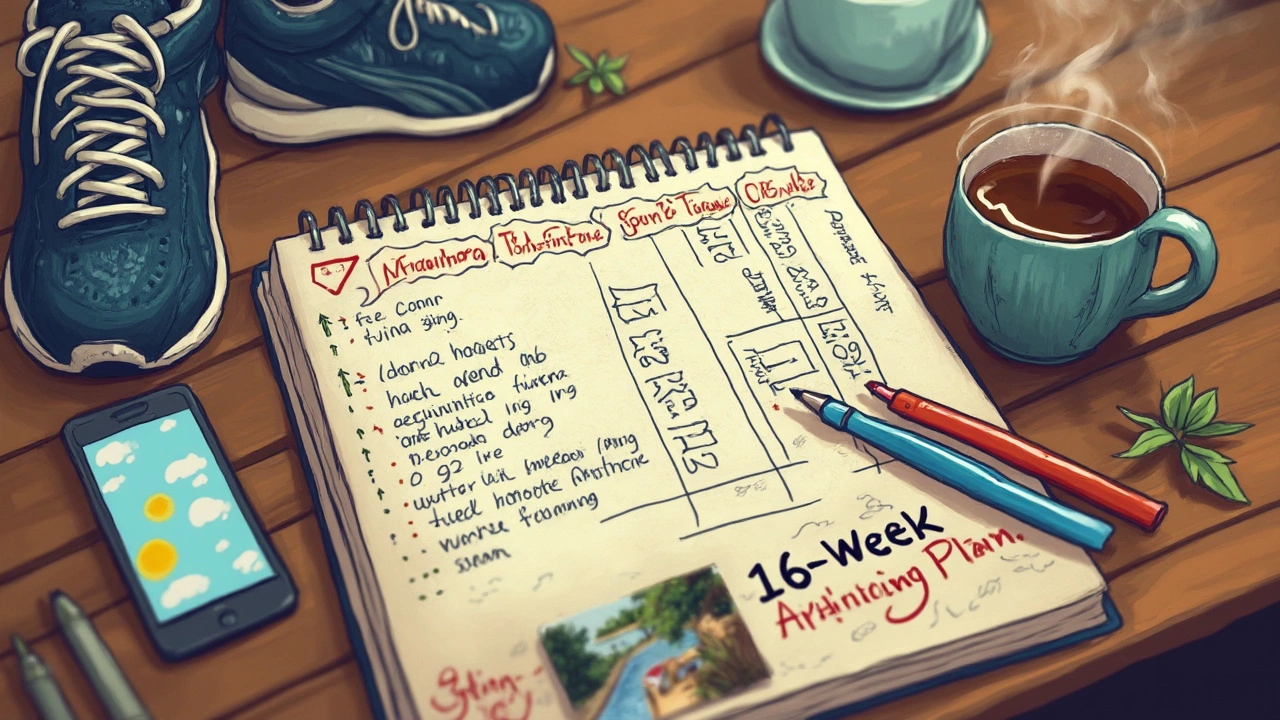How Long to Train for a Marathon for Beginners: Your Realistic Timeline

Wondering how long you actually need to train before crossing that marathon finish line? You’re not alone. Most first-timers are shocked when they discover it takes more than just a couple of months to get ready for 26.2 miles. The usual sweet spot? Somewhere between four to six months, with most plans landing at about 16 to 24 weeks.
No, you can’t really cram for a marathon. Your body needs time to adapt—think stronger muscles, tougher joints, and a heart that won’t give up on you mile twenty. Even if you’re pretty active, marathons are a different beast. Missing out on training weeks just sets you up for injury, burnout, or bailing halfway through the race. The training isn’t just about distance; it’s about learning what pace you can handle, when you hit a wall, and what food or shoes just don’t agree with you.
If this feels like a big time commitment, that’s because it is. Training routines typically mean you’ll be running around three to five times a week and slowly building up your longest run each weekend. But hey—lots of beginners manage it with jobs, families, and busy lives. The key is to give your body the respect it deserves and not rush the buildup. Spoiler: most pros didn’t get there overnight either. Instead of asking, "How soon can I finish a marathon?" try asking what it’ll take to enjoy those hours out there—and make it to the start line healthy and grinning.
- Is There a Standard Timeline to Train?
- How Your Current Fitness Impacts Training Time
- What to Expect in Each Phase of Training
- Real Life Stories: How Long It Really Takes
- Pro Tips to Make Training Manageable
Is There a Standard Timeline to Train?
This question pops up all the time, and honestly, there's no one-size-fits-all answer. But here’s the deal for most folks looking to cross that marathon finish line for the first time—training usually takes between 16 to 24 weeks if you’re starting from scratch. That timeline is backed by major running organizations. For example, the marathon training plans on the official Boston Marathon and New York City Marathon websites are built around a four to six month commitment.
Why is that range the standard? Because your body needs to get used to long distances without breaking down. For total beginners—those who can just about jog a mile—the lower end of the training spectrum just isn't realistic. You’ll thank yourself later for not rushing it.
Here’s a typical breakdown:
- Four months (16 weeks): Enough for those with a solid running base (comfortably running 3 miles, 3–4 times a week).
- Five to six months (20–24 weeks): Best for brand-new runners or anyone needing more time for gradual mileage increases.
Let’s see what a week from a beginner’s schedule might look like:
| Week | Long Run (miles) | Total Weekly Mileage | Number of Runs |
|---|---|---|---|
| 1 | 3 | 10 | 3 |
| 8 | 8 | 22 | 4 |
| 16 | 20 | 35 | 5 |
It’s clear the ramp-up is steady—no crazy leaps in distance. Coaches constantly remind runners not to bump up mileage by more than 10% a week, as it’s the best way to avoid nagging injuries.
Put simply, the 16–24 week plan is the gold standard because it works for a wide range of people. Push things faster, and most beginners risk giving up or getting hurt. Or as Hal Higdon, legendary marathon coach, says:
“Give yourself time. The marathon isn’t just about the finish line, it’s about getting to the starting line healthy and excited to run.”
Following those timelines lets you build endurance, learn how your body responds to training, and keep injuries at bay. Want to make it feel less intimidating? Take it week by week instead of eyeing the whole four or five months at once. That’s what all the smart beginners do.
How Your Current Fitness Impacts Training Time
Your starting point matters more than you think when planning out your marathon journey. If you can already run a few miles, you’re going to have a much different experience than someone who gets winded after chasing a bus. The better your current fitness, the shorter your overall training time tends to be, but that doesn’t mean you can skip the basics. Most beginners, though, fit into three camps—fresh off the couch, occasional jogger, or regular runner. Each group needs a different approach.
| Starting Point | Recommended Training Duration | Weekly Starting Mileage |
|---|---|---|
| Couch to Marathon (no active background) | 20-24 weeks | 0-5 miles |
| Occasional Runner (runs 1-2x per week) | 16-20 weeks | 5-10 miles |
| Regular Runner (runs 3+ times per week) | 12-16 weeks | 10-20 miles |
If you’re coming from the couch, you’ll want those extra weeks to build a habit safely. Besides preventing injury, it helps your body ease into the long haul—shin splints and sore joints are no joke if you ramp up too fast. Those who already get in some runs weekly have a head start, but still need to gradually boost distance and tackle longer runs. Anyone already clocking decent weekly mileage will have an easier transition, focusing more on endurance and marathon-specific pace rather than just surviving each session.
Keep this in mind: taking shortcuts rarely works out. The American College of Sports Medicine suggests increasing your total weekly mileage by no more than 10% each week. This rule helps you dodge common rookie mistakes like stress fractures or burnout. If you try to jump from running a 5K to marathon distance too quickly, even a strong willpower won’t magically make your legs marathon-ready.
And if you come from a background in cycling, swimming, or another endurance sport, you'll still need time to let your bones and muscles adapt to the pounding of running. Cardio helps, but nothing swaps for running-specific strength.
Bottom line: Your personal starting line determines your marathon timeline. Be honest about where you’re at and give yourself enough weeks with a marathon training plan that matches your fitness. Surprises are fun at birthday parties, not during a 20-mile training run.

What to Expect in Each Phase of Training
Getting ready for your marathon isn’t just about logging miles—each stretch of your marathon training plan has its own goal. Here’s how most plans break it down so you know what’s coming up:
- Base Building: The first few weeks are all about getting your body used to regular running. Even if you’re active, easy runs help prevent injury and build a habit. Distances start small—think two to four miles at a time—and gradually increase. Most plans squeeze in some “easy runs,” a longer weekend run, and plenty of rest days.
- Building Endurance: Right after the base phase, you’ll start growing your long run each week. You’ll also add in runs at a comfortable pace but go a little further than before. This is the part where you’ll notice your body changing—legs get stronger, you recover faster, and those three-mile runs become no big deal.
- Peak Training: This is the heart of your marathon prep. Long runs stretch up to 18 or even 20 miles. You’ll tack on extra weekly mileage and might try tempo runs or intervals. These runs teach you to handle fatigue, help your body burn fuel more efficiently, and show you what pace you can realistically expect on race day.
- Tapering: A few weeks before the race, mileage drops so your body can recover and show up rested on race day. It feels weird—almost too easy—but science backs it up. Studies show tapering can boost performance by up to 3%. Stick with your plan and resist the urge to squeeze in “just one more” long run.
Most beginner marathon training plans use this four-phase structure for a reason. Rushing through just means you miss out on the benefits from each part, and your risk of burnout and injury goes way up. Steady progress wins here—trust the process and check off each phase. Small steps really do add up.
Real Life Stories: How Long It Really Takes
If you’re curious about how long regular folks actually spend getting marathon-ready, you’ll find way more honesty in their stories than in official race marketing. Most beginners put in about 18 to 20 weeks, but the range can be shorter or longer depending on lifestyle and fitness habits.
Take Jamie, a 34-year-old who only ran occasionally before signing up for her first marathon. She followed a beginner’s plan for 24 weeks because she wanted to avoid injury and worked full-time. "I needed the extra weeks to balance work and training," she said. Jamie’s weekends were filled with slow, steady long runs that built her confidence.
On the other hand, Marcus, 29, was already active playing soccer and cycling. He jumped into marathon training with a 16-week plan and did fine, but he admitted: "Those last few weeks were a lot tougher than I thought—they weren’t kidding about the long runs being key." Marcus learned that no matter how sporty you are, the demands of marathon distance are on another level.
If you’re more data-driven, here’s a snapshot from six finishers of the 2024 Chicago Marathon. All were first-time marathoners:
| Name | Age | Training Weeks | Weekly Mileage at Start | Finish Time |
|---|---|---|---|---|
| Sarah | 28 | 20 | 12 miles | 4:45 |
| John | 40 | 18 | 15 miles | 5:10 |
| Megan | 32 | 22 | 8 miles | 5:29 |
| Nick | 36 | 16 | 18 miles | 4:13 |
| Priya | 30 | 24 | 0 miles | 5:50 |
| Gabrielle | 45 | 28 | 5 miles | 6:02 |
What jumps out? People with zero or almost no running background usually take 20+ weeks and finish later, but they still get there! Priya went from no running at all to crossing the finish line—she just needed more time on the front end. Nick had a higher starting mileage and needed less time before feeling ready. Gabrielle, who was coming back from an old injury, took it even slower with a 28-week plan and still made her goal.
Every runner’s path looks a little different, but the common thread: more time means fewer injuries, less stress, and a way higher chance of sticking to your plan. With the right marathon training, even total newbies can turn marathon day into a win—just give yourself a big enough runway.

Pro Tips to Make Training Manageable
Not everyone has endless hours to dedicate to marathon training, so you’ve got to work smarter, not harder. The truth is, most beginners who stick with their marathon training plan long-term are the ones who make it fit their everyday life. Here’s how you can pull it off without flipping your whole world upside down:
- Set a Realistic Schedule: Look at your calendar and slot your runs where you know you’ll actually do them. Early mornings, lunch breaks, or after work — whatever sticks. Don’t try to mimic someone else’s routine if your life is nothing like theirs.
- Mix Up Your Runs: You don’t have to run hard every day. Include easy runs, a long slow run on weekends, and throw in one speed or hill workout. This keeps training interesting and helps your legs recover without slacking off.
- Cross-Train Smart: Activities like cycling, swimming, or even brisk walking help build endurance and prevent overuse injuries. It’s also a mental breather if pure running starts feeling like a chore.
- Keep an Eye on Sleep and Recovery: It’s wild, but some studies have shown runners who get less than 7 hours of sleep a night are twice as likely to get injured than those who hit that 7 to 9 hour window. Don’t skimp — your body does most of the work repairing while you snooze.
- Make Friends With Food: You burn through a lot of carbs and calories when you train. Eating isn’t just about not being hungry — it’s fuel for tomorrow’s run. Think grains, lean proteins, fruits, and nuts. Hydration matters just as much; even being mildly dehydrated can slow you down.
- Track Progress, Not Perfection: Use a simple running app or a basic notebook. Celebrate the runs you complete, even if you had to slow down or walk a little. Some of the best lessons come from off days, not perfect ones.
Here’s what a sample week looks like for a beginner working full time:
| Day | Workout |
|---|---|
| Monday | Rest or light cross-training (like cycling) |
| Tuesday | Short easy run (30 min) |
| Wednesday | Rest or yoga |
| Thursday | Tempo run (short run with a few faster minutes thrown in) |
| Friday | Rest |
| Saturday | Long run (gradually increasing, starting from 5-6 miles in early weeks) |
| Sunday | Easy 30-45 min run or brisk walk, gentle stretching |
Stick to a plan like this, tweak as needed, and remember: the real win comes from being consistent week after week, not just crushing a single day or two. And if you ever miss a run? Shrug it off and get back on track — you’re playing the long game.
